
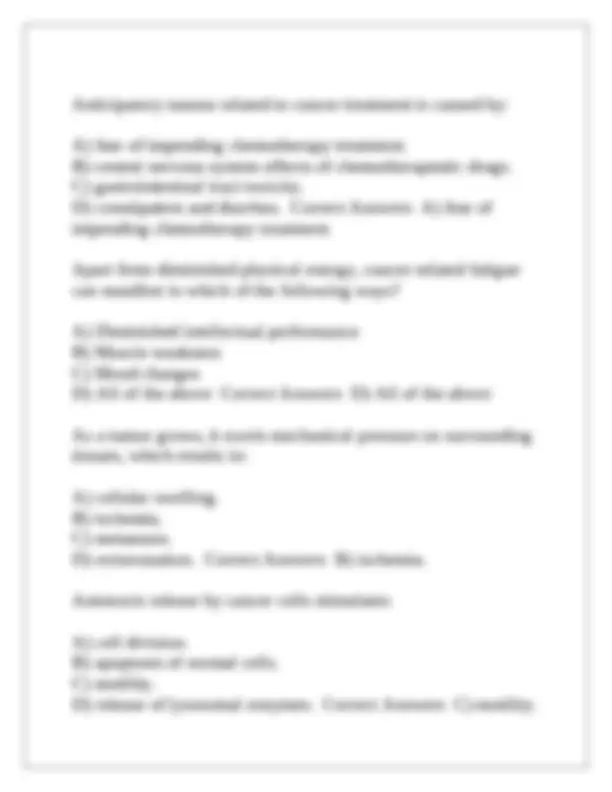
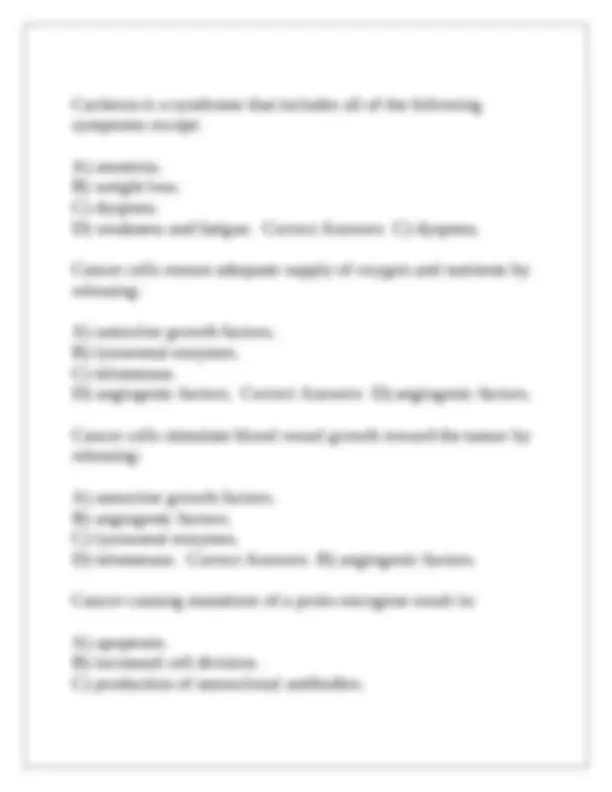
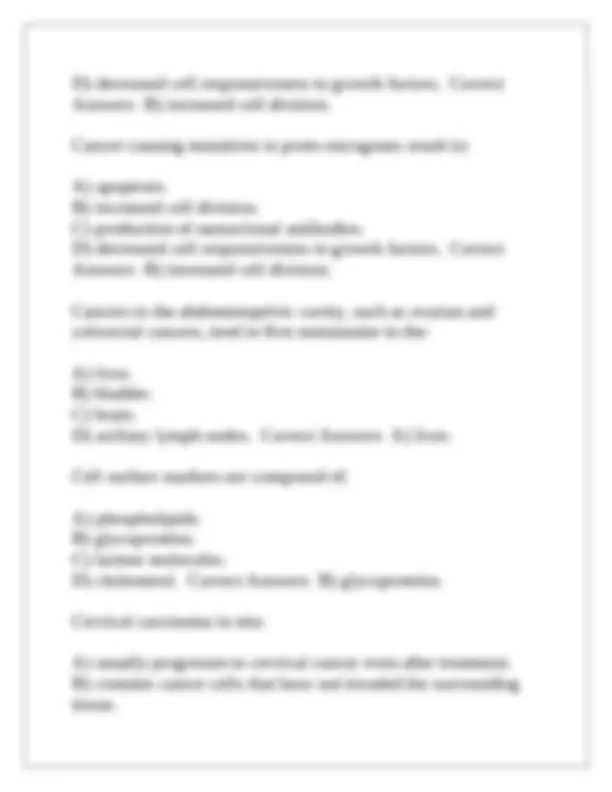
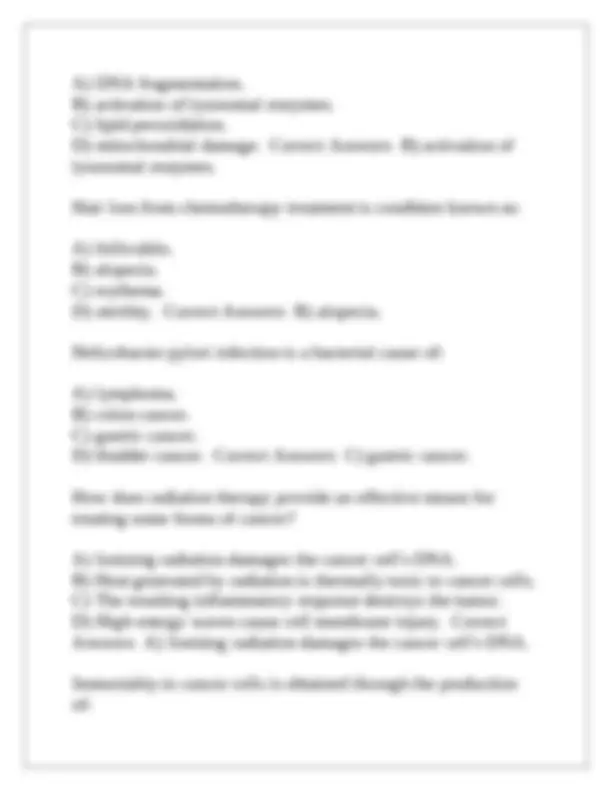
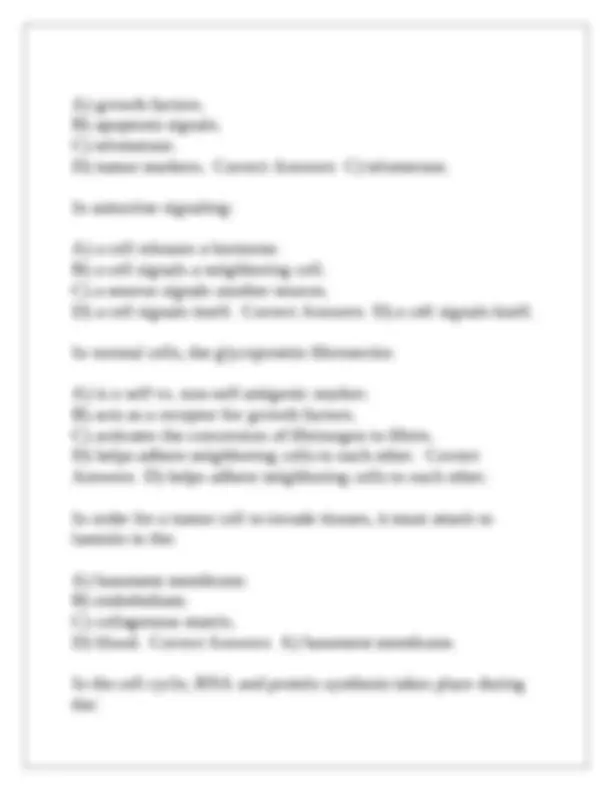
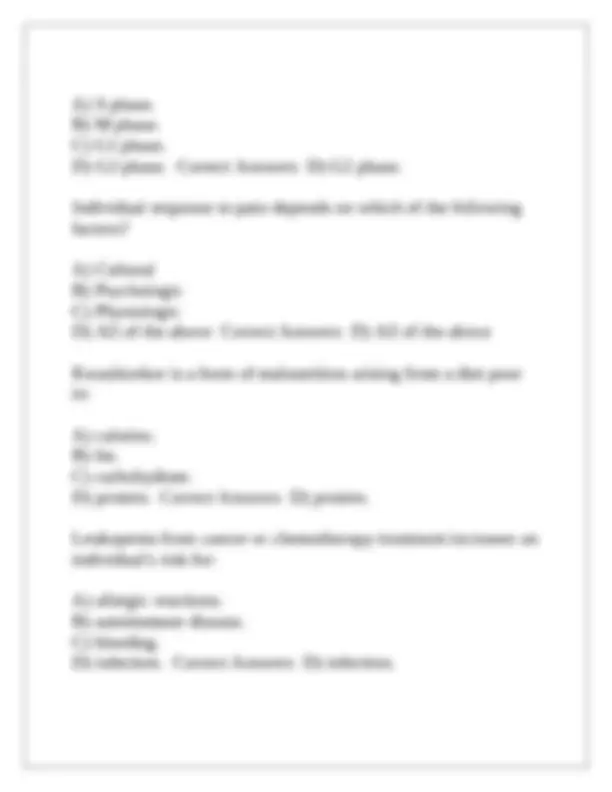
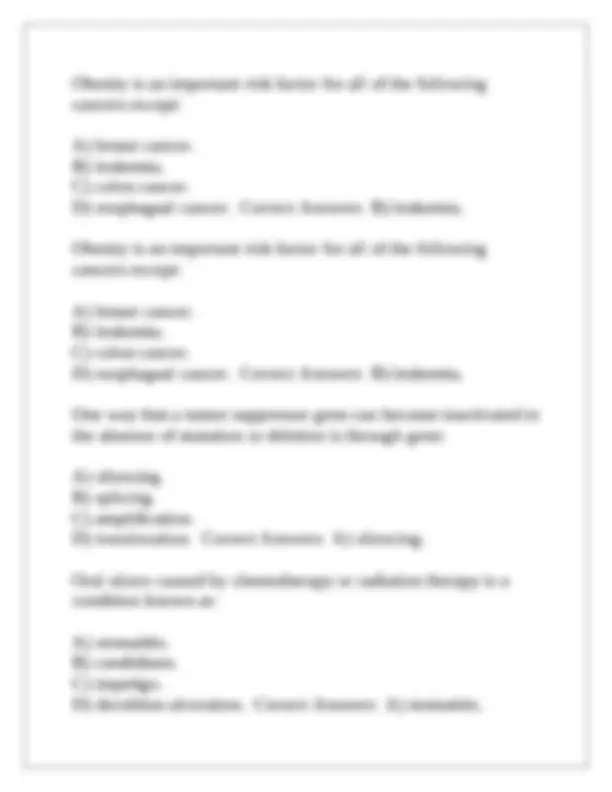
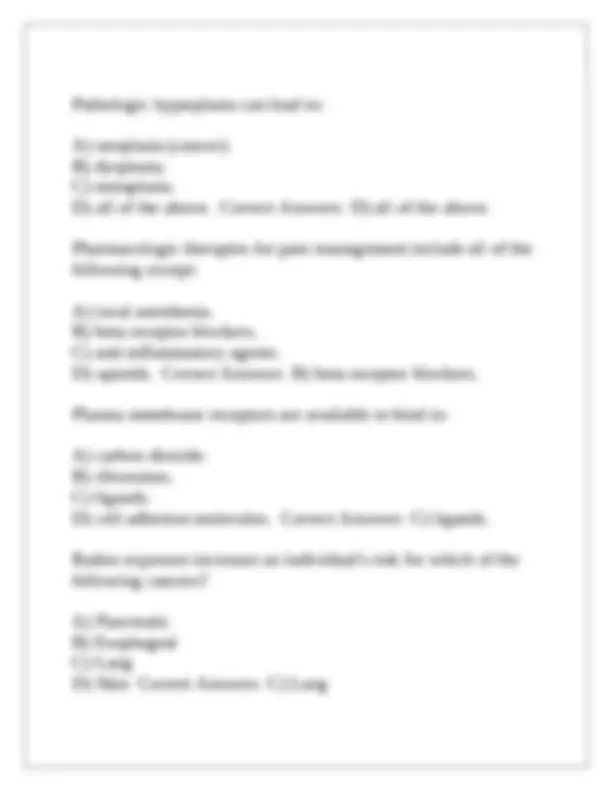
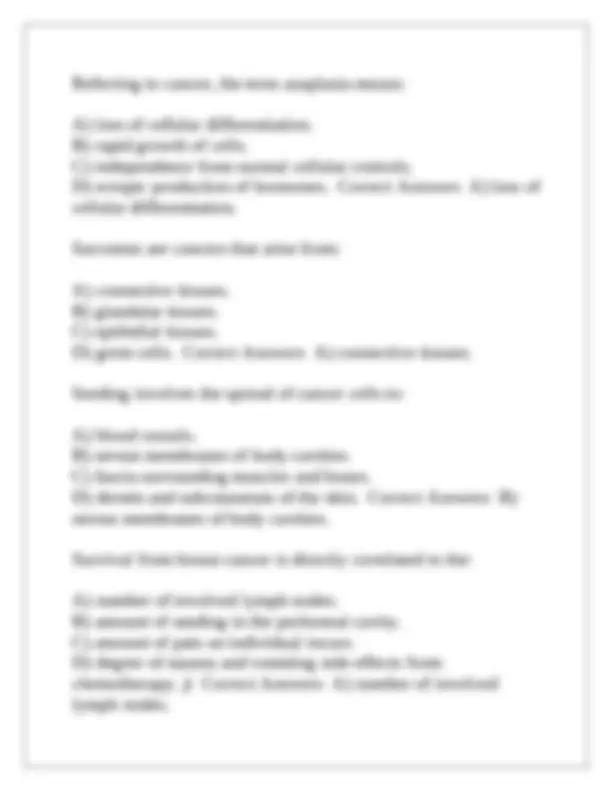
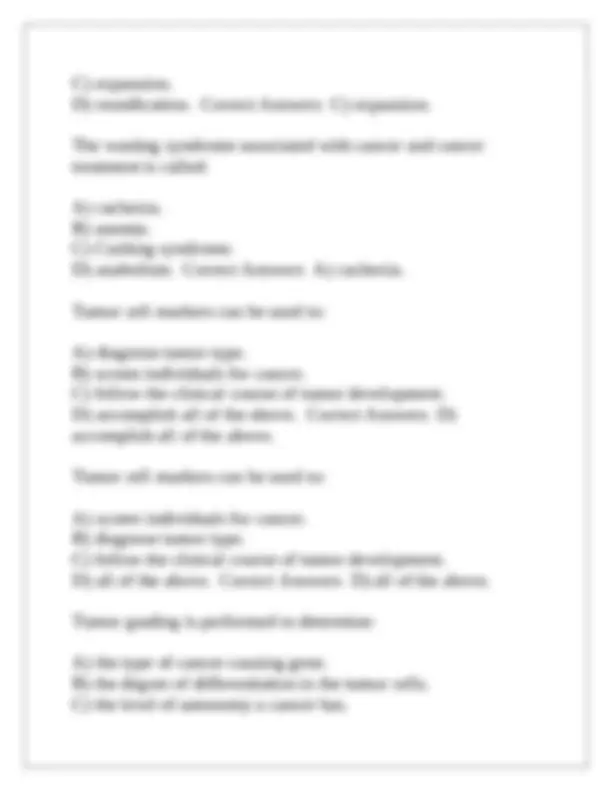
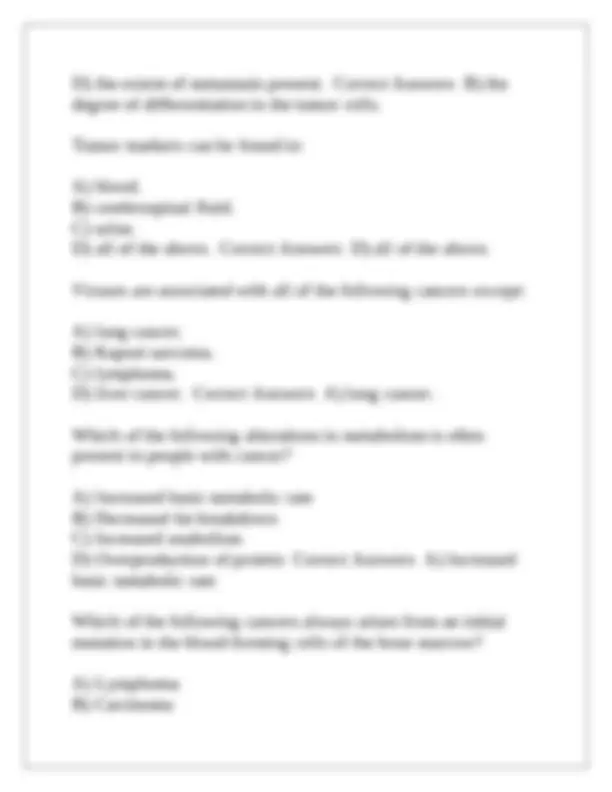
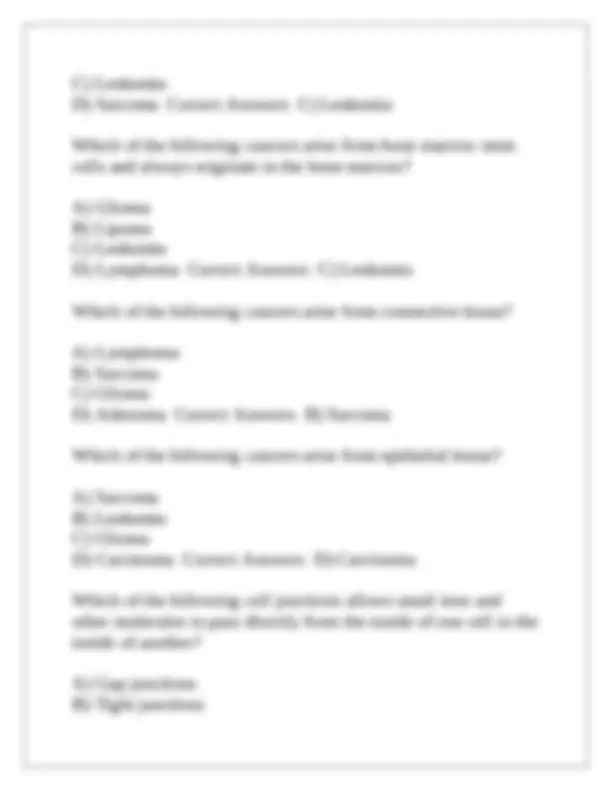
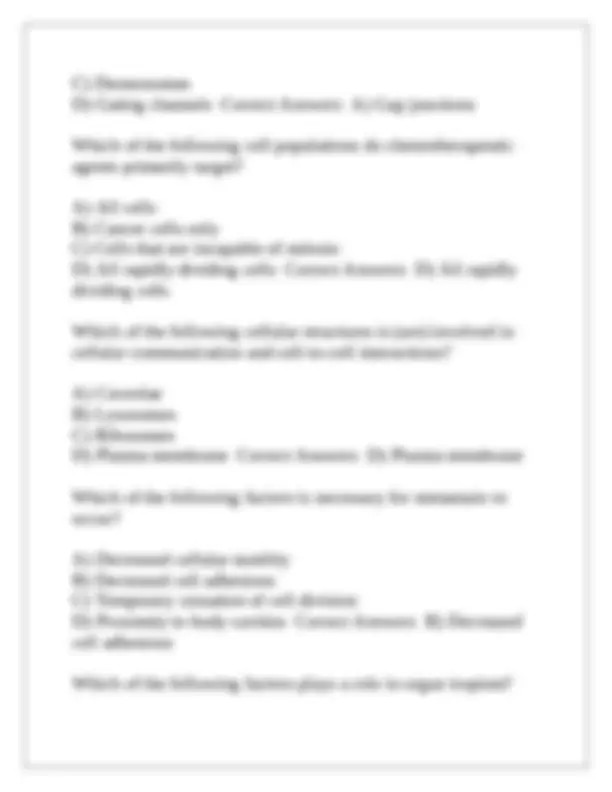
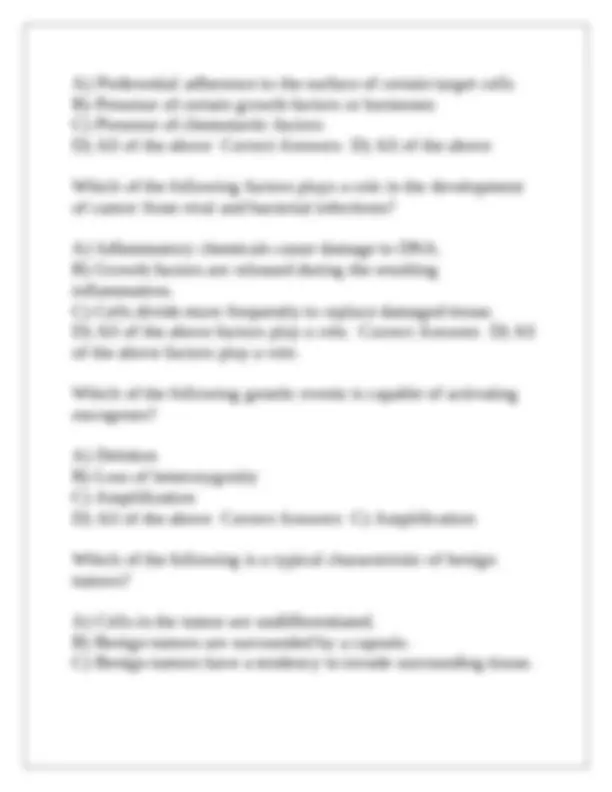
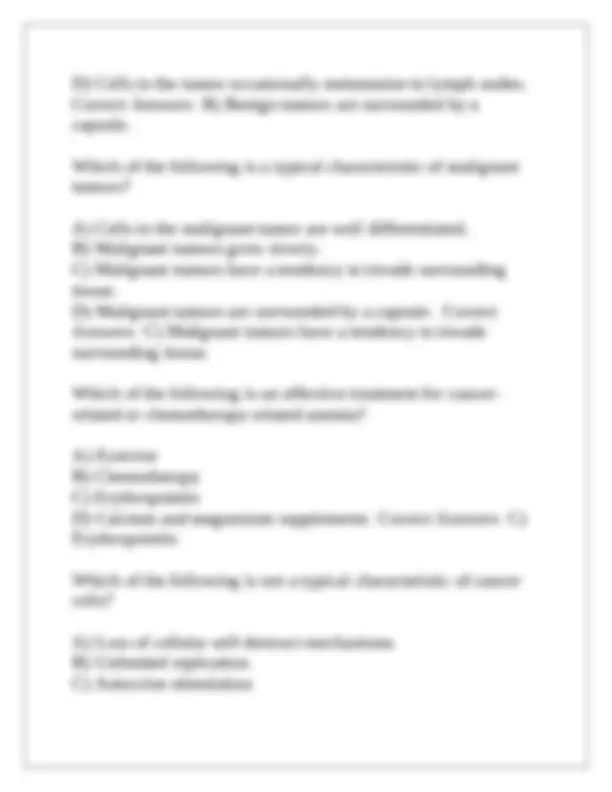
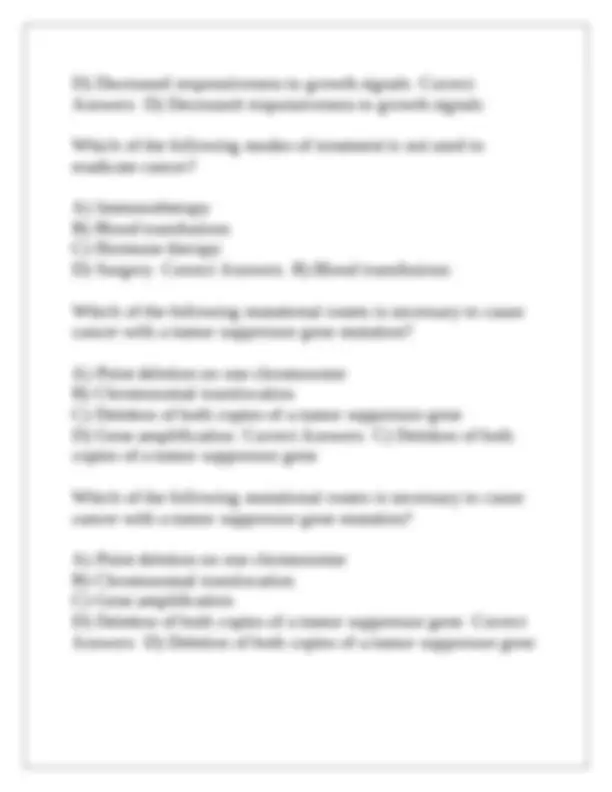
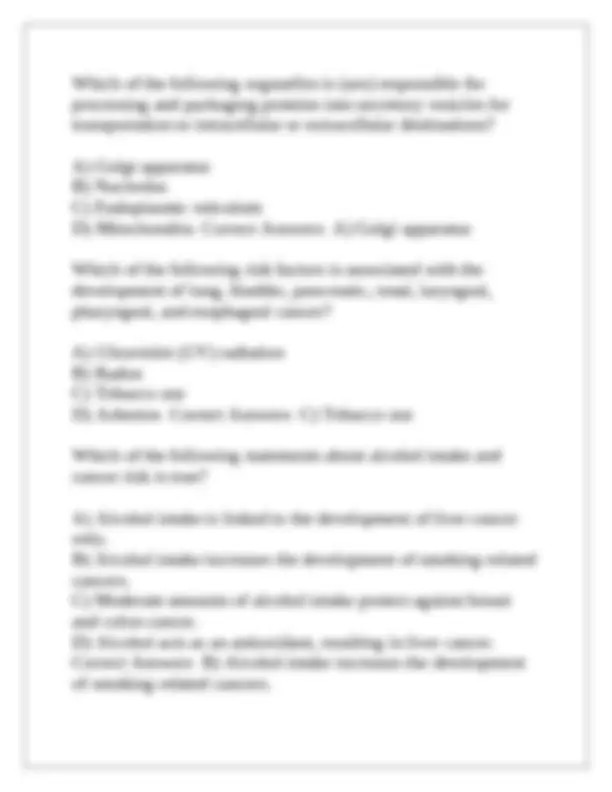
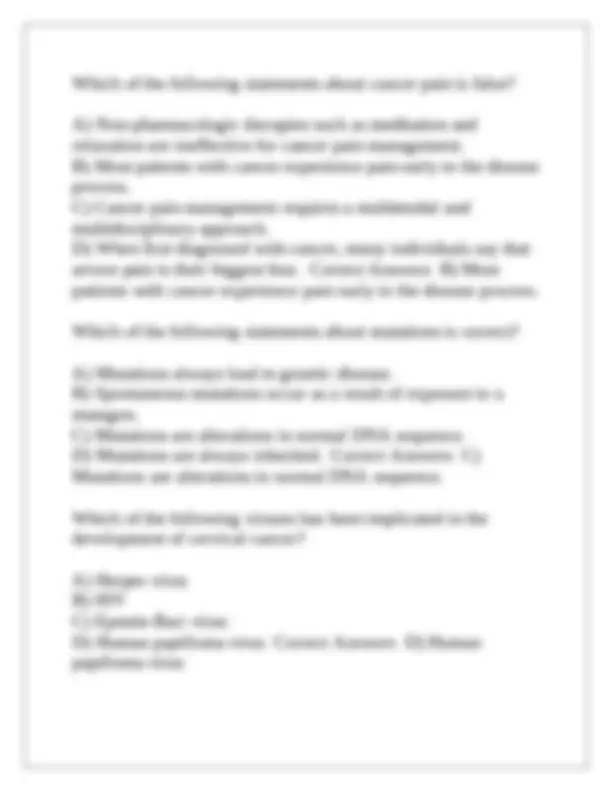


Study with the several resources on Docsity

Earn points by helping other students or get them with a premium plan


Prepare for your exams
Study with the several resources on Docsity

Earn points to download
Earn points by helping other students or get them with a premium plan
Community
Ask the community for help and clear up your study doubts
Discover the best universities in your country according to Docsity users
Free resources
Download our free guides on studying techniques, anxiety management strategies, and thesis advice from Docsity tutors
A series of multiple-choice questions and answers related to the biology of cancer and tumor spread. It covers various aspects of cancer development, including proto-oncogenes, tumor staging, metastasis, dietary carcinogens, cancer-related fatigue, and treatment methods. The questions provide a comprehensive overview of key concepts in cancer biology and can be used for self-assessment or study purposes.
Typology: Exams
1 / 26

This page cannot be seen from the preview
Don't miss anything!



















Florida Atlantic NGR 6141 Module 7: Biology of Cancer and Tumor Spread Questions With Complete Solutions A proto-oncogene is best defined as: A) a normal gene. B) a frameshift mutation. C) an inactive gene. D) a tumor-suppressor gene. Correct Answers A) a normal gene. A tumor that has distant lymph node involvement but no evidence of distant metastasis to other tissues is classified as: A) Stage I. B) Stage II. C) Stage III. D) Stage IV. Correct Answers C) Stage III. A tumor that has regional lymph node involvement only is classified as: A) Stage I. B) Stage II. C) Stage III. D) Stage IV. Correct Answers B) Stage II. After cancer cells metastasize into lymphatic vessels, which of the following events occurs? A) Cancer cells are killed by immune cells in the lymph nodes.
B) Cancer cells lodge in the lymph node and proliferate. C) Cancer cells continue past the lymph nodes to distant organ sites. D) All of the above can occur. Correct Answers D) All of the above can occur. All of the following dietary substances are known carcinogens except: A) fiber. B) polyunsaturated fats. C) charbroiled beef. D) nitrates (nitrosamines). Correct Answers A) fiber. Alterations in carbohydrate metabolism in people with cancer causes: A) hypoglycemia. B) depressed carbohydrate absorption. C) weight gain. D) a diabetes-like syndrome. Correct Answers D) a diabetes- like syndrome. Anemia in individuals with cancer can be the result of all of the following except: A) decreased erythropoietin. B) chronic bleeding. C) fatigue. D) malignant cells in the bone marrow. Correct Answers C) fatigue.
Cachexia is a syndrome that includes all of the following symptoms except: A) anorexia. B) weight loss. C) dyspnea. D) weakness and fatigue. Correct Answers C) dyspnea. Cancer cells ensure adequate supply of oxygen and nutrients by releasing: A) autocrine growth factors. B) lysosomal enzymes. C) telomerase. D) angiogenic factors. Correct Answers D) angiogenic factors. Cancer cells stimulate blood vessel growth toward the tumor by releasing: A) autocrine growth factors. B) angiogenic factors. C) lysosomal enzymes. D) telomerase. Correct Answers B) angiogenic factors. Cancer-causing mutations of a proto-oncogene result in: A) apoptosis. B) increased cell division. C) production of monoclonal antibodies.
D) decreased cell responsiveness to growth factors. Correct Answers B) increased cell division. Cancer-causing mutations to proto-oncogenes result in: A) apoptosis. B) increased cell division. C) production of monoclonal antibodies. D) decreased cell responsiveness to growth factors. Correct Answers B) increased cell division. Cancers in the abdominopelvic cavity, such as ovarian and colorectal cancers, tend to first metastasize to the: A) liver. B) bladder. C) brain. D) axillary lymph nodes. Correct Answers A) liver. Cell surface markers are composed of: A) phospholipids. B) glycoproteins. C) lactose molecules. D) cholesterol. Correct Answers B) glycoproteins. Cervical carcinoma in situ: A) usually progresses to cervical cancer even after treatment. B) contains cancer cells that have not invaded the surrounding tissue.
A) categorization. B) staging. C) factoring. D) processing. Correct Answers B) staging. Exposure to ionizing radiation is linked to all of the following cancers except: A) leukemia. B) thyroid cancer. C) breast cancer. D) skin cancer. Correct Answers D) skin cancer. Exposure to ionizing radiation is linked to all of the following cancers except: A) thyroid cancer. B) leukemia. C) melanoma. D) breast cancer. Correct Answers C) melanoma. Free radical injury can be caused by: A) tissue damage by antioxidants. B) radiation injury. C) excess amounts of vitamin C and E. D) the presence of edema. Correct Answers B) radiation injury. Free radicals cause tissue injury by all of the following mechanisms except:
A) DNA fragmentation. B) activation of lysosomal enzymes. C) lipid peroxidation. D) mitochondrial damage. Correct Answers B) activation of lysosomal enzymes. Hair loss from chemotherapy treatment is condition known as: A) folliculitis. B) alopecia. C) erythema. D) sterility. Correct Answers B) alopecia. Helicobacter pylori infection is a bacterial cause of: A) lymphoma. B) colon cancer. C) gastric cancer. D) bladder cancer. Correct Answers C) gastric cancer. How does radiation therapy provide an effective means for treating some forms of cancer? A) Ionizing radiation damages the cancer cell's DNA. B) Heat generated by radiation is thermally toxic to cancer cells. C) The resulting inflammatory response destroys the tumor. D) High-energy waves cause cell membrane injury. Correct Answers A) Ionizing radiation damages the cancer cell's DNA. Immortality in cancer cells is obtained through the production of:
A) S phase. B) M phase. C) G1 phase. D) G2 phase. Correct Answers D) G2 phase. Individual response to pain depends on which of the following factors? A) Cultural B) Psychologic C) Physiologic D) All of the above Correct Answers D) All of the above Kwashiorkor is a form of malnutrition arising from a diet poor in: A) calories. B) fat. C) carbohydrate. D) protein. Correct Answers D) protein. Leukopenia from cancer or chemotherapy treatment increases an individual's risk for: A) allergic reactions. B) autoimmune disease. C) bleeding. D) infection. Correct Answers D) infection.
Local tissue invasion by a tumor is accomplished by which of the following mechanisms? A) Release of cytokines by the tumor cells, which kills surrounding cells B) Release of lytic enzymes by the tumor cells, which causes tissue degradation C) Release of antibodies by the tumor cells, which enhances phagocytosis of surrounding tissue D) Release of free radicals by the tumor cells, which damages surrounding tissue Correct Answers B) Release of lytic enzymes by the tumor cells, which causes tissue degradation Major causes of fatigue related to cancer and cancer therapy listed by the National Cancer Institute include all of the following except: A) chronic stress. B) disordered sleep. C) immunosuppression. D) metabolic disturbances. Correct Answers C) immunosuppression. Malignant tumors have a tendency to: A) grow rapidly. B) metastasize to distant tissues. C) invade surrounding tissues. D) all of the above. Correct Answers D) all of the above. Mechanisms that cause cancer pain include all of the following except:
Obesity is an important risk factor for all of the following cancers except: A) breast cancer. B) leukemia. C) colon cancer. D) esophageal cancer. Correct Answers B) leukemia. Obesity is an important risk factor for all of the following cancers except: A) breast cancer. B) leukemia. C) colon cancer. D) esophageal cancer. Correct Answers B) leukemia. One way that a tumor suppressor gene can become inactivated in the absence of mutation or deletion is through gene: A) silencing. B) splicing. C) amplification. D) translocation. Correct Answers A) silencing. Oral ulcers caused by chemotherapy or radiation therapy is a condition known as: A) stomatitis. B) candidiasis. C) impetigo. D) decubitus ulceration. Correct Answers A) stomatitis.
Pathologic hyperplasia can lead to: A) neoplasia (cancer). B) dysplasia. C) metaplasia. D) all of the above. Correct Answers D) all of the above. Pharmacologic therapies for pain management include all of the following except: A) local anesthesia. B) beta receptor blockers. C) anti-inflammatory agents. D) opioids. Correct Answers B) beta receptor blockers. Plasma membrane receptors are available to bind to: A) carbon dioxide. B) ribosomes. C) ligands. D) cell adhesion molecules. Correct Answers C) ligands. Radon exposure increases an individual's risk for which of the following cancers? A) Pancreatic B) Esophageal C) Lung D) Skin Correct Answers C) Lung
The extension of cancer to distant tissues and organs is called: A) apoptosis. B) tropism. C) metastasis. D) malignancy. Correct Answers C) metastasis. The less differentiated a cancer cell is, the more: A) benign it will be. B) embryonic it will appear. C) similar it will appear to its tissue of origin. D) all of the above. Correct Answers B) embryonic it will appear. The most commonly reported symptom in individuals with cancer is: A) fatigue. B) anorexia. C) nausea. D) depression. Correct Answers A) fatigue. The normal function of tumor suppressor genes in an individual without cancer is to: A) prevent apoptosis. B) control production of anti-growth signals. C) stimulate cell replication.
D) prevent cancer-causing mutations. Correct Answers B) control production of anti-growth signals. The primary function of the nucleus is to: A) control molecular movement into and out of the cell. B) regulate cell division and control genetic information. C) release enzymes that detoxify harmful substances. D) form the skeletal framework for the cell. Correct Answers B) regulate cell division and control genetic information. The process of cancer cells entering into blood vessels is called: A) tropism. B) embolism. C) intravasation. D) angiogenesis. Correct Answers C) intravasation. The process of triggering new blood vessel formation in a tumor is called: A) erythropoiesis. B) atherosclerosis. C) angiogenesis. D) seeding. Correct Answers C) angiogenesis. The term used to describe an aggregation of cancer cells that accumulates faster than its non-mutant neighbors is clonal: A) selection. B) stimulation.
D) the extent of metastasis present. Correct Answers B) the degree of differentiation in the tumor cells. Tumor markers can be found in: A) blood. B) cerebrospinal fluid. C) urine. D) all of the above. Correct Answers D) all of the above. Viruses are associated with all of the following cancers except: A) lung cancer. B) Kaposi sarcoma. C) lymphoma. D) liver cancer. Correct Answers A) lung cancer. Which of the following alterations in metabolism is often present in people with cancer? A) Increased basic metabolic rate B) Decreased fat breakdown C) Increased anabolism D) Overproduction of protein Correct Answers A) Increased basic metabolic rate Which of the following cancers always arises from an initial mutation in the blood-forming cells of the bone marrow? A) Lymphoma B) Carcinoma
C) Leukemia D) Sarcoma Correct Answers C) Leukemia Which of the following cancers arise from bone marrow stem cells and always originate in the bone marrow? A) Glioma B) Lipoma C) Leukemia D) Lymphoma Correct Answers C) Leukemia Which of the following cancers arise from connective tissue? A) Lymphoma B) Sarcoma C) Glioma D) Adenoma Correct Answers B) Sarcoma Which of the following cancers arise from epithelial tissue? A) Sarcoma B) Leukemia C) Glioma D) Carcinoma Correct Answers D) Carcinoma Which of the following cell junctions allows small ions and other molecules to pass directly from the inside of one cell to the inside of another? A) Gap junctions B) Tight junctions